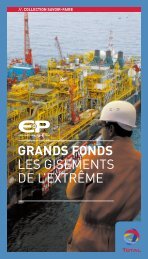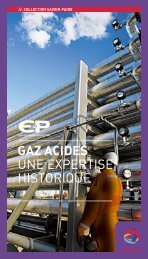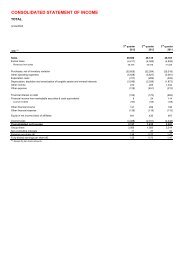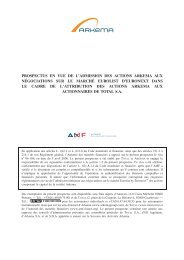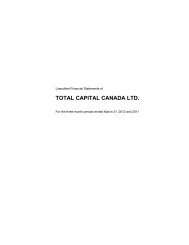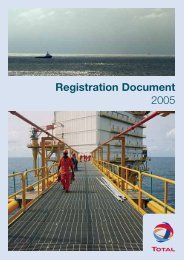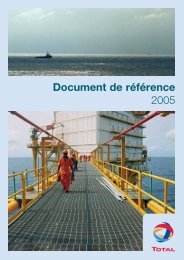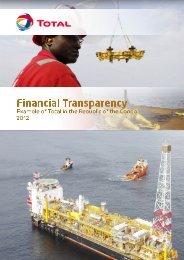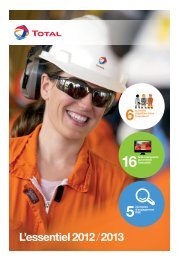Registration document 2007 - Total.com
Registration document 2007 - Total.com
Registration document 2007 - Total.com
You also want an ePaper? Increase the reach of your titles
YUMPU automatically turns print PDFs into web optimized ePapers that Google loves.
5<br />
110<br />
Corporate Governance<br />
Report of the Chairman of the Board of Directors (Article L 225-37 of the French Commercial Code)<br />
Internal control procedures<br />
The internal control framework adopted by TOTAL is that of the<br />
Committee of Sponsoring Organizations of the Treadway<br />
Commission (COSO). In this framework, internal control is a<br />
process intended to provide reasonable assurance that the<br />
following will be achieved: effective and efficient operational<br />
control, accurate reporting of financial information, and<br />
<strong>com</strong>pliance with applicable laws and regulations. As for any<br />
system for internal control, there can be no guarantee that all<br />
risks are <strong>com</strong>pletely eliminated.<br />
The Group’s internal control procedures are based on the COSO<br />
framework: design and implementation of internal controls, risk<br />
evaluation process, internal control operation, <strong>document</strong>ation and<br />
reporting internal controls, and supervision of the internal control<br />
system.<br />
Organization and principles of internal control<br />
The Group’s internal control procedures are designed around an<br />
operating environment with three levels: Group, business<br />
segments and profit centers. Each level is directly involved in the<br />
design and implementation of internal controls, as determined by<br />
the level of centralization desired by the Group’s management.<br />
At each of the three levels, internal control procedures are<br />
designed to include specific organizational procedures,<br />
delegation of authority and employee training that conform to the<br />
Group’s overall framework.<br />
The design of internal control procedures is based on key values<br />
that are deeply rooted in the Group’s control environment,<br />
including the integrity, ethical conduct and professional<br />
<strong>com</strong>petence of its employees. The Group’s senior management<br />
receives regular training on the content and the importance of<br />
proper conduct, which is <strong>document</strong>ed in a code of conduct and<br />
available on the Group’s website. Each year, the chief executive<br />
and financial officers of profit centers or subsidiaries provide<br />
internal written representations to the Chief Financial Officer that<br />
they have <strong>com</strong>plied with internal control procedures and that<br />
their financial reporting is accurate.<br />
These control principles have been confirmed and <strong>document</strong>ed<br />
as part of the corporate governance initiative described above.<br />
Risk evaluation<br />
The Executive Committee, with the assistance of the Risk<br />
Committee, the budget management department and the internal<br />
audit department, is responsible for identifying and analyzing the<br />
risks that could have an impact on the Group’s performance.<br />
The principal risks monitored at Group level are: sensitivity to the<br />
oil market environment (oil prices and refining, marketing and<br />
petrochemicals margins); exposure to oil and gas trading risks;<br />
financial markets risks (foreign exchange risk, particularly related<br />
to the dollar, and interest rate risk given the importance of long-<br />
TOTAL – <strong>Registration</strong> Document 2006<br />
term investments in Group’s businesses); legal and political risks<br />
related to the operating and contractual environment of the<br />
exploration and production activities; and industrial and<br />
environmental risks related to the sectors in which the Group is<br />
active.<br />
The “Risk Factors” section of this <strong>Registration</strong> Document<br />
contains a more extensive description of the principal risks faced<br />
by the Group and how the Group manages these risks.<br />
Internal control operations<br />
Internal control procedures, particularly financial reporting<br />
systems, are designed to take into account the specific nature of<br />
these risks and the degree to which operational control is<br />
delegated to the business segments and profit centers.<br />
Management exercises operational control over the Group’s<br />
activities through the Executive Committee’s approval of<br />
investments and <strong>com</strong>mitments, based on defined thresholds.<br />
Non-operating control is primarily based on a strategic plan<br />
which is reviewed annually, an annual budget, monthly<br />
management financial reports with in-depth analysis of<br />
differences between actual and budgeted expenditures, and a<br />
quarterly reconciliation between published accounts and<br />
management reports. These procedures are supervised by the<br />
budget management department and the accounting<br />
department, and are conducted according to accepted financial<br />
reporting methods that conform to the accounting standards<br />
used to publish the Group’s accounts. The financial measures<br />
that are followed and the accounting methods chosen were<br />
selected to accurately report risks and to measure the return on<br />
average capital employed (ROACE).<br />
The Group accounting department monitors changes in<br />
accounting standards on an ongoing basis, particularly<br />
international accounting standards. In 2004, the Group<br />
implemented a transition to IFRS and adapted its internal control<br />
system to reflect this change in reporting standards.<br />
The 2006 consolidated financial statements were prepared in<br />
accordance with IFRS as adopted by the European Union.<br />
The treasury/financing department monitors and manages the<br />
risks related to cash-management activities as well as to interestrate<br />
related and foreign-exchange related financial instruments in<br />
accordance with specific rules defined by the Group’s<br />
management. Cash and cash equivalents, financial positions and<br />
financial instruments are centralized by the treasury/financing<br />
department.<br />
Oil and gas reserves are reviewed by a <strong>com</strong>mittee of experts (the<br />
Reserves Committee), approved by the senior management of<br />
the Exploration & Production division and then confirmed by the<br />
Group’s management.<br />
The Disclosure Committee, whose members are the managers of<br />
the principal non-operating departments in the Group,




